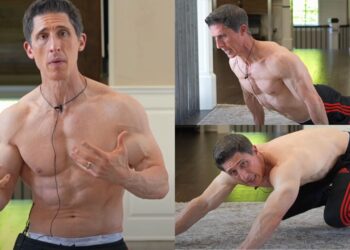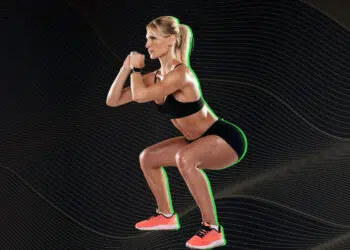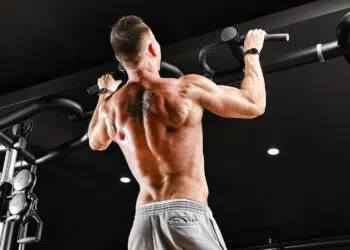Most gyms have exercise steps, sometimes called step platforms. They have a variety of functions but are most commonly used for step aerobics. Often just called step, this workout is good for cardio and fat burning, but is not normally associated with building muscle strength and size.
But, before you write off step platforms, you may be interested to learn that, with a little lateral thinking, they can also be used to train your muscles too. You can often use a step platform instead of an exercise bench – a handy trick for home exercisers – and there are a few exercises that work best using an exercise step.
Here are 12 of the best step exercises for muscle strength, power, and size.
The Best Step Exercises
Before you use a step for strength training, make sure that it is strong enough to support not just your body weight, but any extra equipment you are going to use too. Also, make sure you have set your step-up correctly. The last thing you want it to do is wobble or tip over during your workout. Once your step is set up, and you know that it will support your weight, you’ll be ready to rock and roll!
1- Box Jumps
Box jumps are an effective way to build leg strength and explosive power. However, unlike hurdle jumps, there is much less impact on landing. That’s good news if you are a little on the heavy side, or have painful ankles, knees, or hips. Use this exercise in your warm-up to fire up your leg muscles before squats, or later in your leg workout to provide an unusual training stimulus that will trigger increased muscle growth and performance.
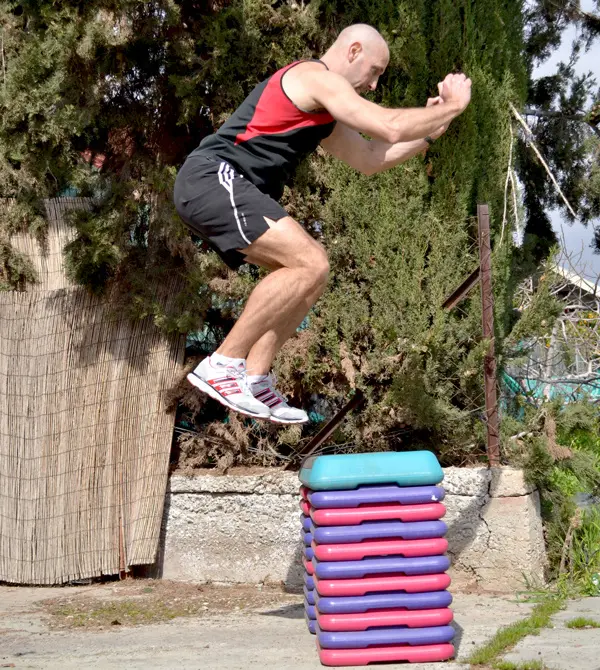
Main muscles worked: Quadriceps, hamstrings, gastrocnemius, soleus, abductors, adductors, and core.
Level Up Your Fitness: Join our 💪 strong community in Fitness Volt Newsletter. Get daily inspiration, expert-backed workouts, nutrition tips, the latest in strength sports, and the support you need to reach your goals. Subscribe for free!
How to do it:
- Set your step up, so it is roughly knee-height. Stand in front of your step with your feet between shoulder and hip-width apart.
- Bend your legs and swing your arms behind you.
- Jump forward and up to land on top of your step. Bend your knees slightly to absorb the shock.
- Carefully step back down, reset your position, and repeat.
- Make this exercise harder by holding dumbbells in your hands, wearing a weighted vest, or using a higher step.
Benefits:
- Good for developing explosive power
- Relatively low impact
- A useful exercise for athletes
2- Decline push-ups
Push-ups are one of the best upper body exercises you can do. However, once you have built up a reasonable level of strength, they may become too easy to be beneficial. Use a step to make push-ups effective again and do decline push-ups instead.
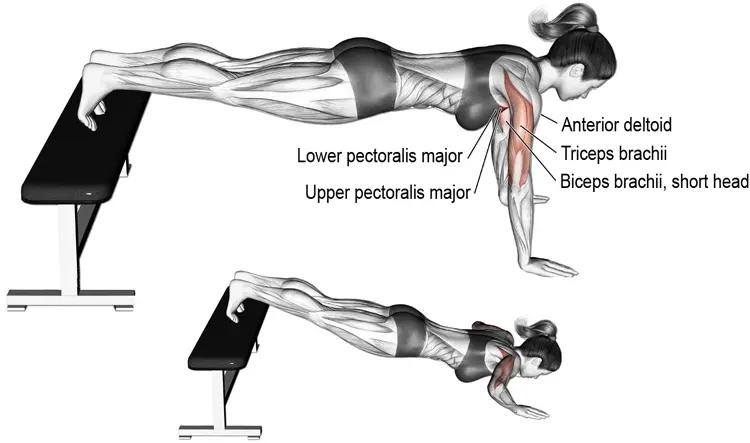
Main muscles worked: Pectoralis major, anterior deltoids, triceps, anterior core.
How to do it:
- Set up your step, so it’s roughly knee-height. With your back to the step, adopt the push-up position with your hands roughly shoulder-width apart. Place your feet on the step.
- With your body straight and your core braced, bend your arms and lower your chest to within an inch of the floor. Push back up and repeat.
- Use a higher step to make this exercise harder and put more weight on your hands.
Benefits:
- A good bench press alternative for home exercisers
- Works your core as well as your arms and chest
- Easy to make harder or more demanding according to your current fitness level
3- Walkover push-ups
This step-based push-up variation not only works your chest and arms; it increases core activation too. It’s a good transitionary exercise between regular push-ups and single-arm push-ups. It will also help improve your balance and coordination.
Main muscles worked: Pectoralis major, anterior deltoids, triceps, anterior core.
How to do it:
- Place your hands on top of your step. Walk your feet back into the push-up position.
- Place one hand on the floor, shift your weight over toward that side, bend your arms, and do a single push-up.
- Walk your hands back onto your step, and then do another rep on the opposite side.
- Keep switching sides rep by rep for the duration of your set.
Benefits:
- Puts more weight through one arm at a time
- Requires and develops good core control
- Makes push-ups fun and exciting again
4- Straddle step squat jumps
This exercise involves a rapid loading/stretching phase followed by an explosive muscle contraction and jump. This makes it a plyometric exercise, which a type of training popular with athletes from almost all sports. Because of the impact on landing, this exercise is not suitable for people with ankle, knee, hip, or lower back problems.
Main muscles worked: Quadriceps, hamstrings, gastrocnemius, soleus, abductors, adductors, and core.
How to do it:
- Stand on your step with your feet together. Jump your feet out to the side and land in a squat position.
- Jump up and bring your feet back together as you land lightly on the top of your step.
- Do your best to minimize ground contact time. Imagine the floor is red hot and spend as little time touching it between jumps as you can.
- Make this exercise harder by using a higher step, wearing a weighted vest, or holding dumbbells in your hands.
Benefits:
- Good for increasing explosive power and jumping ability
- Increase agility and coordination
- Do high (15+) reps for cardiovascular conditioning
5- Box squats
Box squats are typically performed using a wooden box, but not all gyms have one of these. The good news is that if you have an adjustable workout step, you have everything you need to do box squats.
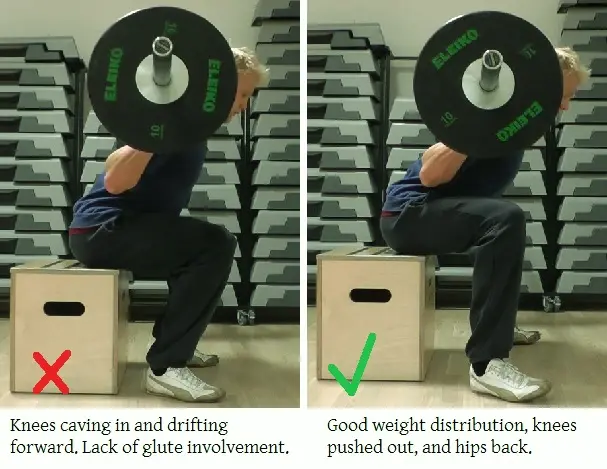
Main muscles worked: Quadriceps, hamstrings, gastrocnemius, soleus, abductors, adductors, and core.
How to do it:
- Set your step to roughly knee-height. Stand with your back to the step in your normal squat stance.
- Push your hips back, bend your knees, and squat down until your butt lightly touches the step.
- Stand up and repeat.
- You can do this exercising with barbell back squats, goblet squats, front squats, overhead squats, Zercher squats, and bodyweight squats.
Benefits:
- Ensures standard depth for all squats
- Teaches you to lead with your hips
- Good for developing explosive power out of the bottom of your squat
6- Single-leg hip thrust with step
Hip thrusts are a popular butt exercise, but doing them with your feet on the floor means they involve a relatively short range of motion. In addition, if you use both legs, you may find this exercise is not especially challenging. This variation fixes both these problems and will work your glutes hard, albeit one leg at a time.
Main muscles worked: Gluteus maximus, hamstrings, Erector Spinae
How to do it:
- Lie on the floor with your legs bent. Place one foot on a knee-high step. Bend and pull your opposite knee in toward your chest.
- Drive your foot into the top of your step and lift your hips off the floor. Keep pushing until your knee, hip, and shoulders form a straight line.
- Lower your butt back to the floor and repeat.
- Do the same number of reps on each leg.
Benefits:
- Good for fixing left-to-right strength imbalances
- Easy on your spine
- A challenging exercise despite not using any weights
7- Plyo push-ups
This push-up variation is designed to boost upper body strength and power. You may also find that it increases chest and triceps muscle mass. However, this is a high impact exercise, so take care if you have wrist, elbow, or shoulder problems.
Level Up Your Fitness: Join our 💪 strong community in Fitness Volt Newsletter. Get daily inspiration, expert-backed workouts, nutrition tips, the latest in strength sports, and the support you need to reach your goals. Subscribe for free!
Main muscles worked: Pectoralis major, anterior deltoids, triceps, core.
How to do it:
- Adopt the push-up position between two steps. They should be slightly wider than shoulder-width apart. Bend your arms and lower your chest to the floor.
- Powerfully extend your arms and jump your hands up and out, so they land on the steps.
- Push off the steps, drop your hands back down to the floor, and drop into another push-up.
- The higher the steps, the more challenging this exercise will be.
Benefits:
- Good for developing upper body power, strength, and muscle size
- A useful exercise for athletes from all sports
- Will increase bench press performance
8- Triceps dips
Parallel bar dips are one of the best triceps exercises around. But, as a bodyweight exercise, they are also quite advanced. After all, doing dips involves lifting your entire body weight using just your arms, and that may be too much weight for some exercisers. This step-based alternative puts less pressure on your hands, making it a more accessible exercise.
Please note: while this can be a good triceps exercise, it can be hard on your shoulder joints too. Minimise the stress on your shoulders by not descending too deep. There is no need to bend your arms beyond 90 degrees. Also, keep your hips under your shoulders and your torso upright. If your hips drift too far forward, you’ll put even more stress on your joints. Skip this one entirely if you have a pre-existing shoulder problem.
Main muscles worked: Triceps, anterior deltoids, pectoralis major.
How to do it:
- Sit on your step with your hands on either side of your hips, fingers pointing forward. Lift your weight forward, so your butt is clear of the step.
- Bend your arms and descend until your elbows hit 90 degrees. Push back up and repeat.
- Move your feet further out in front of you to put more weight on your hands, making this exercise harder.
Benefits:
- A viable alternative to parallel bar dips
- Good for working all three heads of the triceps
- Provides a secondary workout for your deltoids and pecs
9- High step-ups
Step-ups are a very versatile exercise. Low step-ups are great for cardio and toning, whereas high step-ups are an effective strength and muscle-building exercise. The higher your step, the harder this exercise becomes, and the more glute and hamstring activity it will produce.
Main muscles worked: Glutes, hamstrings, quadriceps, abductors, adductors.
How to do it:
- Set your step to at least knee-height. Stand facing your step with your feet together.
- Bend one leg and place your foot flat on the top of your step platform. Drive down through your foot and step up and onto the box. Try not to use your trailing leg to push off the floor. Instead, let your leading leg do all the work.
- Step back down with the same leg and then repeat. Do all your reps on one leg and then, after a rest, swap legs and do the same number on the other side.
- Make this exercise harder by holding dumbbells, wearing a weighted vest, or with a barbell on your back.
Benefits:
- Good for identifying and fixing left-to-right strength imbalances
- Increases mobility, balance, and coordination
- Easy on your lower back
10- Step V-sits
V-sits are a popular old-school abs exercise. While there is nothing wrong with doing V-sits on the floor, using a step increases the range of motion and makes it harder to balance. Go slow and feel the burn!
Main muscles worked: Rectus abdominus, hip flexors.
How to do it:
- Sit on your step with your legs straight out in front of you. Place your hands next to your hips for balance and support. Lean back slightly and lift your feet and inch or two off the floor.
- Bend your legs and pull your knees in toward your chest. Simultaneously crunch your abs and move your upper body toward your legs.
- Sit back and lower your legs again, but don’t touch your feet on the floor.
- Make this exercise harder by wearing ankle weights. You can also add a twist to work your obliques.
Benefits:
- More demanding than regular crunches, sit-ups, and v-sits
- Good for balance and coordination
- Saves you from having to sit or lie on the floor
11- Deficit rear lunges
If you want to work one leg at a time, lunges are hard to beat. As well as being useful for building strength, endurance, and muscle mass, they are also useful for improving your balance and hip mobility. By using a step, this variation increases the range of motion at both your hip and knee joints for a much more demanding workout.
Main muscles worked: Quadriceps, hamstrings, glutes, abductors, adductors.
How to do it:
- Stand on your step with your feet together and hands by your sides.
- Take a large step to the rear, bend your legs, and lower your back knee down toward the floor.
- Push off your back leg and return to your step.
- Alternate legs rep by rep or, if you prefer, do all your reps on one side before switching.
- Make this exercise harder by wearing a weighted vest, holding dumbbells, or using a barbell.
Benefits:
- Easier on your knees than forward lunges
- Works all major leg muscles at the same time
- A good exercise for runner and other athletes
12- Box jump burpees
This CrossFit-inspired exercise works virtually every muscle in your body. If you crank out enough reps, it’ll also send your heart and breathing rate soaring. This is a tough exercise, but it’s also a lot of fun! Use a low step until you know you have the stones to jump up onto a higher platform. You need to commit to every single jump, and that gets harder as you become more fatigued.
Main muscles worked: Quadriceps, hamstrings, glutes, core, pecs, anterior deltoids, triceps, and cardiovascular system.
How to do it:
- Stand around 1-2 feet from your step. Squat down and place your hands on the floor. Jump your feet out and back into the push-up position. Do one, perfect push-up.
- Jump your feet back up to your hands, and then leap up and onto the step. Land with your knees slightly bent.
- Step or jump back down and then repeat.
- For an easier workout, you can omit the push-up part of this exercise. The higher the step, the more challenging this exercise becomes.
Benefits:
- Develops several aspects of fitness at the same time, including muscular endurance, power, and cardiovascular fitness
- Good for athletes
- A demanding exercise that is ideal for circuit and high-intensity interval training
FAQs
Do you have any questions? We’ve got the answers! If you can’t find the answer you want below, drop us a line in the comments section, and we’ll get back to you as soon as we can.
Are step exercises safe?
Most step exercises are very safe but, to make them more so, check that your step is set up properly and that it is strong enough to support your body weight and whatever you are lifting too. Some steps are much stronger than others, so ensure that your step won’t collapse beneath you. Finally, introduce new exercises gradually into your workouts to avoid injury. Make sure you have mastered them before adding too much weight.
Can you use a bench instead of a step?
You can, but the soft upholstery on a bench may mean you won’t be as stable as you would be on a hard-topped step. Some gyms may also be unhappy if you start stepping or jumping onto there expensive benches. Be considerate and put a towel on your bench, especially if you are going to put your feet on it. Also, be respectful if you are asked not to use a bench for a step. After all, it’s not yours!
Are step exercises good for circuit and interval training?
Step exercises are PERFECT for these types of training. In fact, you could have a total body workout using nothing more than a step, a couple of dumbbells, and enough space to move around. Circuit training, interval training, and metabolic resistance training are all great ways to combine strength training with cardio, building muscle and burning fat all at the same time.
How high should my step be?
That depends on the exercise you are doing. Some exercises, such as box jumps, usually require a higher step while exercises such as dips are better on a lower step. In some cases, increasing the height of the step will make your workout harder. Experiment with step height to determine what is best for you.
The wrap-up
While you can use a step box for aerobic exercises, you don’t have to limit yourself to that kind of workout. In fact, armed with a step, some space, and a willingness to work hard, you can use one to work almost every muscle in your body, and build strength, size, power, or endurance.
Because they are light and portable, steps are ideal for home exercisers. You can even use one in place of a weights bench for many barbell and dumbbell exercises. Why not include the best step exercises in your next workout?





